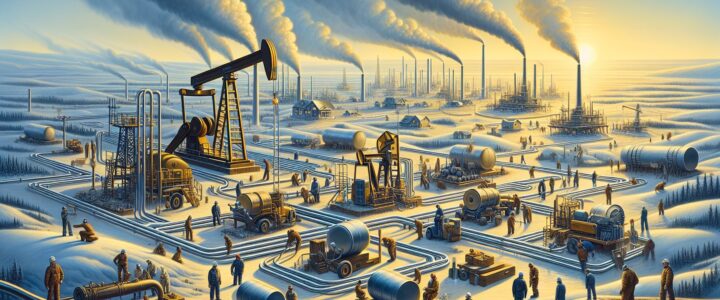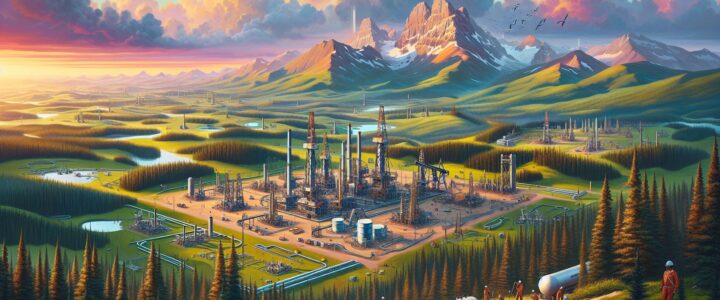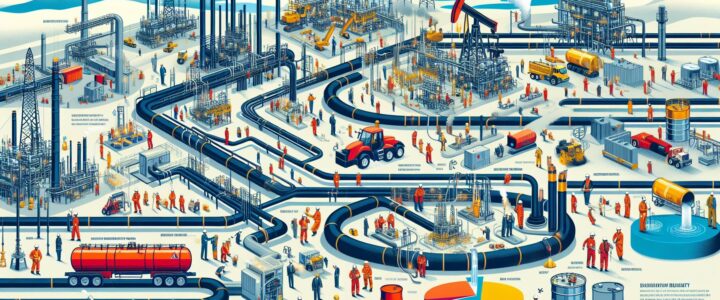The oil and gas industry in Canada has always been a captivating enigma, an ever-changing landscape that has managed to baffle and intrigue both enthusiasts and experts alike. With its unpredictable twists and turns, this industry has often left many scratching their heads in bewilderment. Today, let us embark on a journey through this multifaceted realm that not only provides immense value to the economy but also challenges our perceptions.
The mesmerizing dance between production and consumption unfurls against the picturesque backdrop of Canada’s vast and diverse landscape. From the rocky mountains of Alberta to the serene coastlines of British Columbia, the oil and gas industry weaves its intricate tapestry across the nation. It is an industry that has shaped Canada’s economy, defined its cultural identity, and sparked intense national debates on various topics, ranging from environmental stewardship to economic prosperity.
Canada’s oil and gas reserves are prodigious, catering to both domestic and international energy demands. The oil sands in Alberta stand as a testament to the relentless pursuit of extracting resources from seemingly unconventional sources. These reserves have consistently thrust Canada into the global spotlight, making it one of the top suppliers of oil and gas worldwide.
Amidst the awe-inspiring accomplishments lies a tale of complexity and controversy. The extraction of oil sands, while undoubtedly a technological marvel, also presents unique environmental challenges. The carbon intensity of oil sands extraction has been a hot topic, igniting passionate discussions on climate change and sustainable practices. Striving for a harmonious coexistence between economic development and environmental preservation is an ongoing endeavor, and Canada is at the forefront of this quest.
Regulatory frameworks play a vital role in shaping the industry’s trajectory. Canada’s commitment to responsible resource development has resulted in stringent regulations designed to safeguard the environment. From rigorous assessment processes to the implementation of innovative technologies, the industry strives to strike a delicate balance between economic growth and ecological preservation.
Additionally, the oil and gas industry has emerged as a significant contributor to job creation and the overall economic prosperity of Canada. It has fostered a web of interconnected industries, stimulating growth in sectors such as manufacturing, transportation, and engineering. The industry’s footprint extends far beyond the pump, providing a livelihood for thousands of Canadians and fueling innovation and opportunity.
However, as with any tale of mystery, there are unforeseen plot twists that disrupt the harmony. Pandemics, geopolitical complexities, and fluctuating global energy prices have introduced new dimensions to Canada’s oil and gas industry. These challenges have prompted introspection, adaptation, and diversification, forcing the industry to reinvent itself continuously.
The winds of change blow fiercely in the form of renewable energy sources. As Canada amplifies its efforts towards a sustainable future, the oil and gas industry is compelled to reinvent its practices, foster technological advancements, and explore cleaner energy alternatives. This metamorphosis presents both challenges and opportunities, as the industry navigates uncharted waters toward a greener horizon.
In conclusion, the oil and gas industry in Canada remains an enigmatic force that has the power to inspire, astonish, and perplex. It intertwines economic growth, environmental stewardship, and social complexity, offering no easy answers or definitive solutions. As Canada continues to evolve, the industry evolves with it—embracing change, surmounting challenges, and redefining its place in the narrative of our nation’s energy landscape.
[Quilbot Edited Version]
The oil and gas industry in Canada has always been a captivating enigma, an ever-changing landscape that has managed to baffle and intrigue both enthusiasts and experts alike. With its unpredictable twists and turns, this industry has often left many scratching their heads in bewilderment. Today, let us embark on a journey through this multifaceted realm that not only provides immense value to the economy but also challenges our perceptions.
The mesmerizing dance between production and consumption unfurls against the picturesque backdrop of Canada’s vast and diverse landscape. From the rocky mountains of Alberta to the serene coastlines of British Columbia, the oil and gas industry weaves its intricate tapestry across the nation. It is an industry that has shaped Canada’s economy, defined its cultural identity, and sparked intense national debates on various topics, ranging from environmental stewardship to economic prosperity.
Canada’s oil and gas reserves are prodigious, catering to both domestic and international energy demands. The oil sands in Alberta stand as a testament to the relentless pursuit of extracting resources from seemingly unconventional sources. These reserves have consistently thrust Canada into the global spotlight, making it one of the top suppliers of oil and gas worldwide.
Amidst the awe-inspiring accomplishments lies a tale of complexity and controversy. The extraction of oil sands, while undoubtedly a technological marvel, also presents unique environmental challenges. The carbon intensity of oil sands extraction has been a hot topic, igniting passionate discussions on climate change and sustainable practices. Striving for a harmonious coexistence between economic development and environmental preservation is an ongoing endeavor, and Canada is at the forefront of this quest.
Regulatory frameworks play a vital role in shaping the industry’s trajectory. Canada’s commitment to responsible resource development has resulted in stringent regulations designed to safeguard the environment. From rigorous assessment processes to the implementation of innovative technologies, the industry strives to strike a delicate balance between economic growth and ecological preservation.
Additionally, the oil and gas industry has emerged as a significant contributor to job creation and the overall economic prosperity of Canada. It has fostered a web of interconnected industries, stimulating growth in sectors such as manufacturing, transportation, and engineering. The industry’s footprint extends far beyond the pump, providing a livelihood for thousands of Canadians and fueling innovation and opportunity.
However, as with any tale of mystery, there are unforeseen plot twists that disrupt the harmony. Pandemics, geopolitical complexities, and fluctuating global energy prices have introduced new dimensions to Canada’s oil and gas industry. These challenges have prompted introspection, adaptation, and diversification, forcing the industry to reinvent itself continuously.
The winds of change blow fiercely in the form of renewable energy sources. As Canada amplifies its efforts towards a sustainable future, the oil and gas industry is compelled to reinvent its practices, foster technological advancements, and explore cleaner energy alternatives. This metamorphosis presents both challenges and opportunities, as the industry navigates uncharted waters toward a greener horizon.
In conclusion, the oil and gas industry in Canada remains an enigmatic force that has the power to inspire, astonish, and perplex. It intertwines economic growth, environmental stewardship, and social complexity, offering no easy answers or definitive solutions. As Canada continues to evolve, the industry evolves with it—embracing change, surmounting challenges, and redefining its place in the narrative of our nation’s energy landscape.




